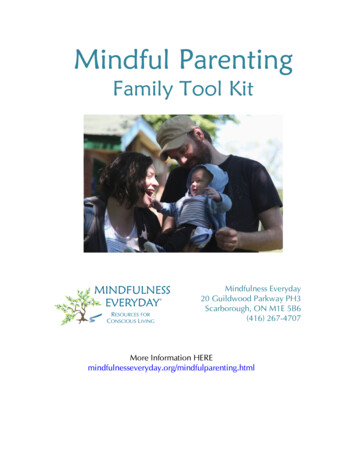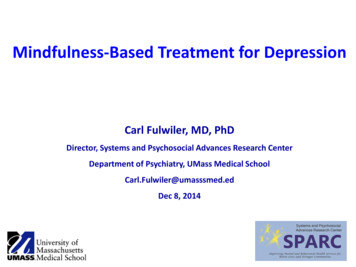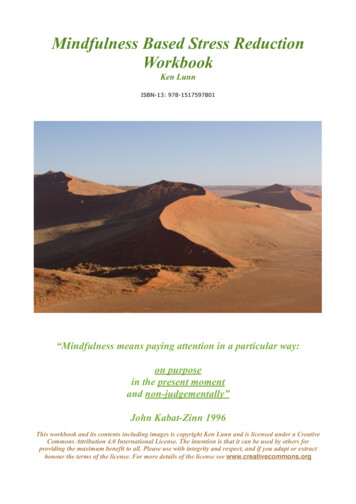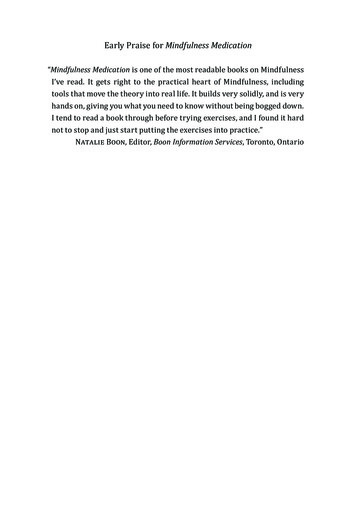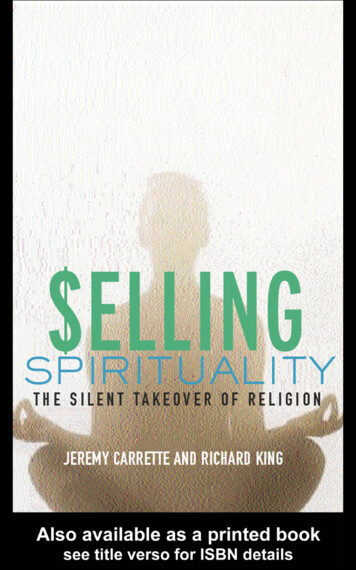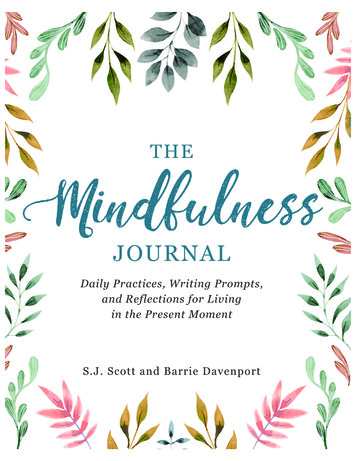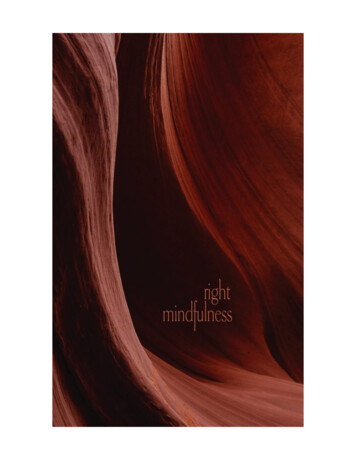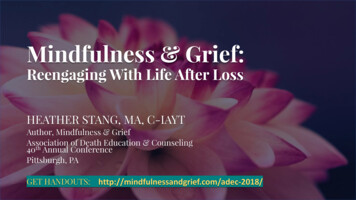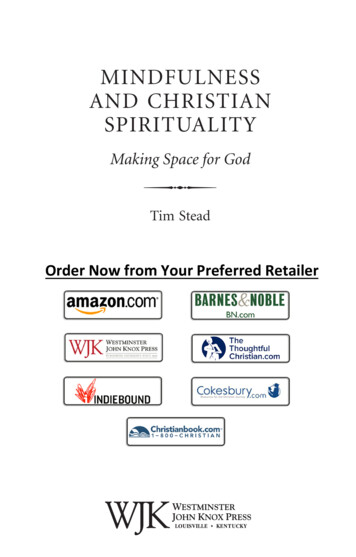
Transcription
MINDFULNESSAND CHRISTIANSPIRITUALITYMaking Space for GodSTim SteadOrder Now from Your Preferred Retailer
Copyright 2016, 2017 Tim SteadForeword 2017 Westminster John Knox PressFirst published in Great Britain in 2016by Society for Promoting Christian KnowledgePublished in the United States of America in 2017by Westminster John Knox Press100 Witherspoon StreetLouisville, KY 4020217 18 19 20 21 22 23 24 25 26—10 9 8 7 6 5 4 3 2 1All rights reserved. No part of this book may be reproduced or transmitted in any form or byany means, electronic or mechanical, including photocopying, recording, or by anyinformation storage or retrieval system, without permission in writing from the publisher. Forinformation, address Westminster John Knox Press, 100 Witherspoon Street, Louisville,Kentucky 40202-1396. Or contact us online at www.wjkbooks.com.Unless otherwise noted, Scripture quotations are taken from the New Revised StandardVersion of the Bible, Anglicized Edition, copyright 1989, 1995 by the Division ofChristian Education of the National Council of the Churches of Christ inthe USA. Used by permission. All rights reserved. Scripture quotations marked NIV are takenfrom the Holy Bible, New International Version (Anglicized edition). Copyright 1979, 1984,2011 by Biblica (formerly International Bible Society). Used by permission of Hodder &Stoughton Publishers, an Hachette UK company. All rights reserved. ‘NIV’ is a registeredtrademark of Biblica (formerly International Bible Society). Scripture quotations marked CEB arefrom the Common English Bible, 2011 Common English Bible, and are used by permission.Extracts from Common Worship: Services and Prayers are copyright The Archbishops’Council, 2000, and are reproduced by permission. All rights reserved.Every effort has been made to seek permission to use copyright material reproduced in thisbook. The publisher apologizes for those cases where permission might not have been soughtand, if notified, will formally seek permission at the earliest opportunity.Cover art: City Walls, limited edition linocut by Giuliana Lazzerini, www.giulianalazzerini.com.Used by permissionLibrary of Congress Cataloging-in-Publication DataNames: Stead, Tim (Anglican priest), author.Title: Mindfulness and Christian spirituality : making space for God / TimStead.Description: Louisville, KY : Westminster John Knox Press, 2017. Includesbibliographical references.Identifiers: LCCN 2016052022 (print) LCCN 2017004073 (ebook) ISBN9780664263164 (pbk. : alk. paper) ISBN 9781611648034 (ebk.)Subjects: LCSH: Meditation--Christianity. Spiritual life--Christianity. Spirituality--Christianity. Theology. Mindfulness (Psychology)Classification: LCC BV4813 .S74 2017 (print) LCC BV4813 (ebook) DDC248--dc23LC record available at https://lccn.loc.gov/2016052022The paper used in this publication meets the minimum requirementsof the American National Standard for Information Sciences—Permanenceof Paper for Printed Library Materials, ANSI Z39.48-1992.Most Westminster John Knox Press books are available at special quantitydiscounts when purchased in bulk by corporations, organizations, and special-interestgroups. For more information, please e-mail SpecialSales@wjkbooks.com.
ContentsSForeword by Eden KozThanksIntroduction: Making Space for GodixxixiiiPart 1WHAT IS MINDFULNESS?1. Mindfulness in Its Clinical and Mainstream Contexts 32. Mindfulness in the Christian Tradition183. My Journey to Mindfulness27Part 2FROM BELIEVING TO KNOWING4. God Is One, God Is Love, God Is Now5. Jesus: The Embodied One, the Liberated One,the Awakened One6. The Holy Spirit: Free Will, Decentering435361Part 3FROM DOING TO BEING7.8.9.10.11.12.13.Knowing God’s PresenceTrusting GodKnowing God’s WillFinding Peace‘Inner Healing’Prayer and WorshipPracticing Love71798693100110118vii
Contents14. Reconnecting with Nature15. Daily Living126132Epilogue: Life in All Its FullnessNotesMindfulness Courses and Further Reading138141143viii
ForewordSI was introduced to Tim Stead’s writing because of an articleI wrote for The Huffington Post titled ‘Can Christians PracticeMindfulness?’ I wrote that piece because I felt I needed to dosomething in response to people’s religious concerns about thepractice, primarily the fear that its Buddhist origins made itunchristian or that it opened a path for the devil. Up until thatpoint, much of my work had been to assure folks that no matter what their background or faith, it was completely fine tomeditate and learn to be mindful. That God would actually behappy with their increased clarity of focus and connection withGod.When Tim Stead’s Mindfulness and Christian Spiritualitycame into my life, the timing was perfection. I had been suffering from a headache that could not be beaten for six straightdays. It wouldn’t stop no matter what medication I used, nomatter what holistic treatment I used, no matter how long Istayed on meditation or practiced my mindfulness. Then camethe dizziness, and I knew something was off. I ended up canceling a flight I had scheduled for a high school reunion. It wasat that point that my husband knew something was wrongbecause back then, I never canceled anything.After a trip to the doc-in-a-box and then the next day to anemergency room, my husband telephoned my parents, beginning with the words, ‘Are you sitting down?’ I went from amisdiagnosis of stage four cancer to a rare bacterial infectionthat required two brain surgeries.I am feeling much better now, getting an IV of antibioticsin the comfort of my own home. Still not 100 percent but verydifferent and very changed. My illness led me to ask: Why didix
Forewordthis book come into my life at this particular time? Why was Iasked to write about it? Why did I need to read it?Reflecting on the intersections of mindfulness and Christianfaith would hold much more significance for me now regardingmy relationship with God and to life. Through this infectionand all that came with it, I saw that I still held much contemptfor myself. I realized that I did too much. But amazingly, I alsofound that I did not fear death, because I had a healthy connection with God. Self-acceptance, simplicity and focus, anddeep connection with God—all of these Tim addresses in hisbook.He easily puts everything in perspective. He makes it clearwhat mindfulness is from a scientific basis and why it is valuable for the practice of one’s Christian spirituality. Mindfulnesslinks us all, makes us all better human beings, and takes awayour need to judge ourselves and others. As Jesus urged his followers: ‘Do not judge, so you will not be judged’. Tim couldno longer live with such judgment in his life. I give him greatkudos and a huge nod for his bravery.Tim even has a section on nature and ecology—how mindfulness makes you more aware of everything around you—notonly of your body but also of your environment and the earth.Spirituality isn’t just about what is inside of us but everythingthat surrounds us. Tim showcases how loving the environmentand all of its creatures is of Christian importance.Thank you, Tim, for bringing your book to an Americanaudience, for making such a contribution to mindfulness,and for letting me be a part of it.Eden KozFounder of Just Be, LLCA Meditation, Mindfulness & Modern Wellbeing CompanyAkron, Ohiox
Introduction: Making Space for GodS‘What – another book about mindfulness?!’ You may have noticedhow books on mindfulness are multiplying like coat hangersin a wardrobe. There is ‘mindfulness and this’, ‘mindfulnessand that’, and soon, probably, ‘mindfulness and the other’. It isclearly the big new thing and therefore probably time to getcynical about it and start wearing the ‘I don’t do mindfulness’T-shirt.However, there is very little on mindfulness and Christianity.This seems to me somewhat curious as there are so many overlaps, and something that is the big new thing surely ought tohave a Christian response.I wonder whether there are two reasons for this. One mightbe that we feel we already have two millennia and more ofspiritual tradition behind us and so perhaps this is just ‘spiritu ality’ for those who don’t belong to any faith. In other words,we don’t really need it. And the other is that we have heardthat mindfulness has its roots in Buddhism. Now this couldbe good or bad depending on your point of view, but it is stilla ‘competing’ religion, isn’t it, and surely I should be lookingto my own faith for my spiritual practices?Well, all this may be true – or true enough. But there areother questions that may still linger in the mind:llllllllllCould it be that Christianity is still learning?Are we open to insights of other faith traditions?Is there more of our own tradition that remains generallyunexplored?Are we open to the insights of science?Are we up for a further stage in the adventure of Christianfaith and spirituality?xiii
Introduction: Making Space for GodIf the answer to any or all of these questions in your own mindis ‘yes’ – even a qualified ‘yes’ – then this book may be worthreading.But first, let me say something about the approach of thisbook, beginning with what it is not. It is not a textbook on mind fulness, nor is it a mindfulness course. Plenty of these havealready been written and are definitely worth turning to if youwant to explore mindfulness for yourself in its own right. (A listof good books and where to find a course can be found at theback of this book.) Neither is this a theological treatise. Rather,it seeks to ask the question: ‘What might mindfulness have tooffer Christianity?’ I could have chosen to have a go at answering the question the other way round: ‘What does Christianitythink of mindfulness?’, but actually the former question seemsmuch more interesting and full of possibilities – and perhapssomewhat humbler. So, although I will take time to say something of what mindfulness is and what is beneficial about itin Part 1, I am assuming that it is accepted that it is basi callya good thing. Essentially, as psychologists are suggesting, thisis about having a healthy mind, just as physical exercise and agood diet lead to a healthy body. But I want to go further thanthis and suggest that mindfulness might have a part to play inhelping Christians to respond to the call of Christ in our lives.I have always had two burning questions when I have thoughtabout my faith:1. Does it make sense?2. Does it make a difference?As far as the first question is concerned, apart from my earliestdays as a Christian, when I simply took everything as read,I have always been someone who has wrestled with belief andthe statements of faith that we proclaim. There have been timeswhen I have simply wanted to say, ‘I can’t believe that.’ Butin the end, that has seemed a bit presumptuous, and anywayit doesn’t really lead me anywhere. So, what has seemed a morexiv
Introduction: Making Space for Godinteresting question has been, ‘I wonder what we really meanby saying that?’ – about God, about Jesus, or whatever. Thiskeeps the question open and the quest alive. So Part 2 will taketime to reflect on what mindfulness might have to offer interms of what and how we believe.The second question has been almost more pressing for me.I know that Christian faith offers comfort, inspiration, and asense of purpose, but can it actually change anything? Or are wesimply forever ‘moving the deckchairs around on the Titanic’– offering ‘opium for the people’ because basically the news isbad and always will be? I deeply want a faith and a spiritualpractice that works – that can make a difference to my life andreally change things for the better in all of our lives. Added to thisis that many of us are acutely aware of a kind of faith thatlays down very clearly what we ought to be or what we oughtto do, but feel a constant sense of failure in the extent to whichwe have actually been able to live up to such expectations.And that is just the reasonably humble and self-aware ones!My New Testament teacher at theological college used to remarkon how people would say to him that they weren’t really Christianbut they did live by the Sermon on the Mount. To which hewould reply, ‘Have you read the Sermon on the Mount?!’ If theyhad, he would surmise, they would have realized that the idealis, in fact, impossible. For those who have realized this, though,it may not be quite enough simply to accept God’s forgivenessfor our failure. We do genuinely want to find ways of responding, growing, moving toward this ideal, however slowly. So,does our Christian faith work? Does it make any difference?Mindfulness, for me, also has a part to play in enabling ourfaith to work for us, and in Part 3 I will suggest some ways inwhich this might be true.Part 1, though, addresses the question, ‘What is mindfulness?’This is not a mini course, but I hope it will provide a basicunderstanding of mindfulness itself. I approach it in three ways:first, by telling the story of the development of mindfulness inxv
Introduction: Making Space for Godits clinical and academic contexts; second, by reflecting on mind fulness in the Christian tradition; and finally, by reflecting onmindfulness from the perspective of my own faith journey.However, an important point to note at every stage is thatmindfulness is truly appreciated only at an experiential level.Because of this, practical exercises are interspersed throughoutthe book, which you are welcome to have a go at. These are nomore than tasters, but will, I hope, give balance to the mainlyreflective material.Finally, a word on the subtitle of the book: Making Space forGod. We cannot save ourselves. We cannot even heal ourselves.Christians believe that only God, in Christ, is our Savior andhealer. But there is something we can do – and need to do –and that is to make space for God to come to us. We can chooseto open ourselves up and invite the work of grace into our lives.This may be familiar language, but still it raises the question:‘But how do we do this opening up and inviting in?’ It is mysuggestion that mindfulness offers us a way of opening up,inviting in – making space for God.xvi
Part 1WHAT IS MINDFULNESS?S
1Mindfulness in Its Clinical andMainstream ContextsSIf you already know the basics of mindfulness or have evencompleted a course, then you might want to skip this chapter(although, equally, you might just be interested in my ownslant). But for those who don’t have a basic knowledge, thischapter covers how mindfulness has emerged in the past 40 years(first in clinical settings and lately in all sorts of mainstreamcontexts), what it actually is, how it is taught generally, andhow I have been teaching it in the parish context.HistoryThe story goes back to the 1970s when Jon Kabat-Zinn, witha PhD in molecular biology from the Massachusetts Instituteof Technology, began to develop a meditation-based programto help support people suffering from chronic pain. KabatZinn had been introduced to the practice of meditation a fewyears earlier and was influenced by the world-renown Buddhistteacher Thich Nhat Hahn, among others. Kabat-Zinn was bornJewish but suggests that his worldview was more stronglyformed by the science and art learned from his parents thanby any religious context. Similarly, when he discovered meditation it was not the religious aspects that drew him but thehealth value of the practices. He does not identify as a Buddhistany more than he identifies as a Jew, but rather he has exploredall that he has been exposed to in relation to his own scientific3
What Is Mindfulness?context. So, when he began to realize that the practices he wasengaging with might have some significant health benefits, hedeveloped an eight-week program that later became known asMindfulness Based Stress Reduction (MBSR). He offeredthis in the University of Massachusetts Medical School anddemonstrated through controlled tests that the course couldsignificantly reduce anxiety and stress in patients, and in par ticular help people to find an alternative way of managing chronicpain. The program has been running ever since and is nowavailable all over the world.There is a very moving video, Healing and the Mind (availableon YouTube1), of Kabat-Zinn teaching a class of people withsevere, untreatable chronic pain of all kinds, showing how thepractices helped to transform the lives of the participants. Thesepatients had already exhausted all the possibilities provided byconventional medicine for elimination of their pain. Mindfulnesspractice was not being offered as another way to eliminate pain,however. Instead, MBSR taught the participants a new way ofrelating to their pain. This reduced the considerable degree ofstress with which most people usually respond to pain, and this,in turn, reduced the perceived experience of pain to the extentthat many could take fewer painkillers and often either go backto work or engage in activities they had previously withdrawnfrom. But the most striking thing about the video, which seemsto me particularly important to note, is the compassion thatseems to flow from the teacher. Kabat-Zinn appears genuinelyto care for his patients in a heartfelt way. If, as Kabat-Zinn says,this is really all science, then it was science with a difference,because it included as a necessary fundamental element thelived-out experience of love.Fast-forward to the 1990s and we find a group of cognitivebehavior therapists on two continents reflecting on the effectiveness of their treatment for long-term sufferers of depres sion.Recall that, up until then, psychiatry and psychology had beenfocusing on how to treat depression once people were already4
Mindfulness in Its Clinical and Mainstream Contextsin the midst of an episode. Cognitive behavior therapy (CBT)had been shown to have been a very successful treatment sincethe 1970s, but what Mark Williams, John Teasdale, and ZindelSegal were finding was that a major problem for people withdepression was that it keeps coming back – it is a ‘recurrent’problem – especially for those treated with antidepressantmedication. These psycho logists thought that such recurrencemight be due to the fact that, for many who have suffered pastepisodes of depression, a new episode is more and more easilytriggered. For these people, any small initial low mood couldactivate a whole chain of associations, forming into negativethought patterns that then compound and deepen the moodinto a full-blown depression. CBT was known to help reducerecurrence, but no one knew how it had its therapeutic effects.Segal, Williams, and Teasdale suggested that CBT had implicitly been teaching people a way to step back from the viciouscycle of their thoughts rather than constantly getting caughtup in them. If this is how success ful treatment actually worked,could the same skill be taught to those who were known to bevulnerable to future depression even when they were well? Buthow could this be achieved? It was at this time that they becameaware of Kabat-Zinn’s work in Massachusetts, through his pub lications, which had begun to emerge in the early 1990s.So, the CBT experts traveled to America, took part in theMBSR program, and came to realize that this could be themissing piece to their own jigsaw. After one or two false starts,most notably making the mistake of thinking that mindfulnesscould be taught by people who were not actually practicing itthemselves, they developed an eight-week program calledMindfulness Based Cognitive Therapy (MBCT). This was basedheavily on the MBSR program but was adapted to focus on theneeds of long-term sufferers of depression. CBT was still inthere, as it had been shown to be so effective in the past, butit was now ‘front-loaded’ with mindfulness. Essentially, partici pants were shown a way of disengaging from their negative5
What Is Mindfulness?thought processes in order to create space around them beforethen employing some gentle CBT techniques.The initial results were dramatic. Compared to control groupswho continued with treatment as normal (that is, continuingwith whatever their usual treatment might be, including goingback to medication if they needed to), those who took part in theMBCT program showed a reduction in episodes of relapse byup to 50 percent. And it seems to be reduction in relapse forchronic sufferers that is the key achievement. It is generallyadvised that sufferers of depression take part in an MBCT pro gram, if possible while they are feeling well. This is partlybecause the program is quite demanding in itself and partlybecause but what it teaches is the skills needed to avoid relapse.Once again it is important to note that compassion is built intothe way the program is taught. Those who have developed thecourse have been motivated over the decades by their sense ofcompassion and have realized that this is a key part of thehealing process. A final point to note is that, partly because ofthese initial results and partly because of the unit costs involved(mindfulness can be taught to a group of up to 25 people ata time), our National Health Service here in Britain was fairlyquickly persuaded to back it. General practitioners now refersome patients to mindfulness courses.A DefinitionSo, an extraordinary success story! Mindfulness is a good thing,as declared by psychologists, neuroscientists, and health professionals. But what actually is it and how is it taught?First, a definition: mindfulness can be described as beingmore fully aware of your own experience in the present momentin a nonjudgmental way. There are four vital strands to thisdefinition: awareness, experience, the present moment, andnonjudgment; all are key parts of what mindfulness is. Itmay sound very simple or even naive to suggest that bringing6
Mindfulness in Its Clinical and Mainstream Contextsmindful awareness to things would have any significant effecton the practitioner, but notice how each of these four aspectsis counterintuitive – against the grain of much of our regular‘default’ brain activity – and therefore needs a great deal ofpractice to achieve; and that each aspect plays a significantrole in reducing anxiety and living more freely, which con sequently seems to have such an effect on many other aspectsof our health.The emphasis on awareness is intended to be offered as apowerful antidote to the automatic way our brains tend to workmost of the time. In mindfulness training we refer to this as‘autopilot’. It is important that our brains are able to act automatically (or unconsciously) much of the time, so that we donot have to keep sending a message to our hearts every secondto carry on beating, or consider whether we should jump outof the way of an oncoming bus. But much of our unconsciousbrain activity can be useless at best and dangerous at worst,so the constant practice of bringing awareness to what is goingon in our minds can be a very powerful tool. Awareness, as weshall explore later, leads to greater choice in how we use ourminds.The emphasis on our own experience is intended to counteract the brain’s tendency to overanalyze. Analysis is, again,an important brain function, as many problems can be solvedin this way, but not all. Crucially, very often these exceptionsare not emotional or psychological ones. Whatever the case, theart of drawing closer to what it is we are actually experiencingcan be an important part of the healing process, especially whenanalysis may be being used (even inadvertently) only as a meansto move away from our experiences.Emphasis on the present moment is also a key tool for thoseof us who can spend too much of our time living either inthe past or in the future: worrying, replaying, or even overcelebrating what has happened, or planning what is aboutto happen, while never fully appreciating what is right here in7
What Is Mindfulness?front of us. Too much focus on past or future is associated withbuildup of stress.Finally, bringing a nonjudging attitude is also key if we areto counter the human tendency to repress those things of whichwe are ashamed or embarrassed. Once aspects of ourselvesare repressed, they are less available for healing of any sort.Only when some part of ourselves is fully present in a nonjudging atmosphere (akin, you might say, to that created by a goodpsychotherapist – or even better, God!) can that aspect be morefully understood and be in some way healed.But why not try this little exercise, if you have never done any thing like it before, which illustrates through actual experiencewhat mindfulness is.The Raisin PracticeThis exercise has become a classic in the teaching of mind fulness. It doesn’t have to be done with a raisin; but raisins doseem to work very well.So, find a few moments to yourself, read through these instruc tions, and then see if you can follow them as best you can.1. Take one raisin and place it on the palm of your hand. Youare going to eat it at some point, but not yet!2. First, take time simply to see the raisin sitting there on yourhand and explore all the visual aspects of this raisin. I knowyou know it is a raisin and you have seen many before, butyou have never seen this one, never at this point in time,and never in precisely your current state of mind. So, seeif you can see this raisin as though you have never seenone before and you just want to experience it as fully aspossible. See the smoothness and the rough patches; thevarious shades of color; the way the light plays on the sur face; whether you can see any shadows, etc.8
Mindfulness in Its Clinical and Mainstream Contexts3. Then, when you feel ready, pick the raisin up between your thumband forefinger and begin to explore its texture and how itfeels to the touch. Perhaps roll it around between your fingersand see how the texture changes over time or as it warms up.4. Next explore its smell by bringing it up to your nose. What doyou notice? If you have a cold, there may be no smell! If so,then notice simply the absence of smell; but if there is smell,allow yourself to become aware of it for a few moments. Smellis often complex, and there may be more than one kind of aromaaround, including, of course, the smell of your own fingers.5. Now place the raisin on your tongue. Don’t chew or swallowyet, if you can manage it, but explore the sensations in themouth caused by having a raisin on the tongue. You mighteven move it around to see how other parts of the mouthrespond to the introduction of this raisin.6. Now, when you feel ready, bite into the raisin and notice theflavors that are released, and, again, how the different partsof the mouth respond to these flavors. Where are the flavorsmost noticeable? Where else are they apparent?7. Finally, but only when you have decided to, swallow the raisin.But let the practice not end there; stay with your attentionand notice all the after-effects on your mouth, throat, andbody of having swallowed the raisin.When we teach mindfulness in classes, after this practice wesimply invite participants to say something of what they experi enced, or noticed in their own experience, during the practice.The array of responses is astonishing and rather wonderful. Allwe have done is eat a raisin, but people express a wide rangeof things about a raisin they had never noticed before, and allsorts of thoughts that popped up in their minds in responseto what the raisin had triggered. One participant traveled (inher mind) all the way down to the south coast of England and9
What Is Mindfulness?was in her mother’s kitchen at Christmas while the Christmaspudding was being prepared. And all I had asked her to do wasto eat a single raisin!Your experience may be different: boredom, irritation, dislikeof raisins, self-conscious thoughts about what on earth youare doing when you thought you were going to learn aboutsome new life-changing spirituality! All these may be present.But it doesn’t matter what we experience or notice, only thatwe notice it.How wonderful, then, to go about life in this way: fully awaketo the myriad different experiences that are going on aroundand within us all the time; delighting in things we had nevernoticed before – the subtle colors, aromas, and textures ofall we encounter; even waking up fully to the thought pro cessesthat are constantly going on in our minds. However, I haveonly just begun to describe a process. It may sound simple, butactually it is very difficult – which is why we practice, practice,and practice. Much is said about the practices, but it is theresults of being more mindfully aware that we are seeking.Mindfulness has been shown to have many health benefits; and,I will argue, it has huge benefits for the Christian.Teaching MindfulnessFinally, how is mindfulness taught? This is, for me, part of thegenius of what mindfulness might have to offer the churches.Compare, for instance, how you learned to pray. My own experi ence, even as one who has been quite proactive in seeking tolearn spiritual practice over the decades, has been piecemeal atbest. There are any number of excellent books, from the greatsto the popularizers, and I find that I have learned a bit fromhere and a bit from there over a long period of searching,but often there is no one on hand to help me when I get stuck.So, what about your average churchgoer, who might ask, asJesus’ disciples once asked, ‘How do I pray?’ Well, there are10
Mindfulness in Its Clinical and Mainstream Contextsbooks on prayer and courses about prayer on offer, and eventhe help of a spiritual director if you are really keen, but whereis the course that can simply take you through the basics andget you going? Mindfulness does have such a course; in variousforms, yes, but all drawing from the same well and all equipping you with the basics, from where you can continue to exploreand develop for the rest of your life.Before describing the course I teach, I want to note one furtherdevelopment in the mindfuln
‘What – another book about mindfulness?!’ You may have noticed how books on mindfulness are multiplying like coat hangers in a wardrobe. There is ‘mindfulness and this’, ‘mindfulness and that’, and soon, probably, ‘mindfulness and the other’. It is cle
